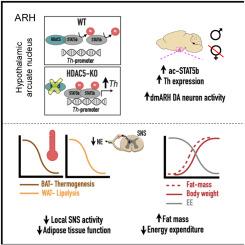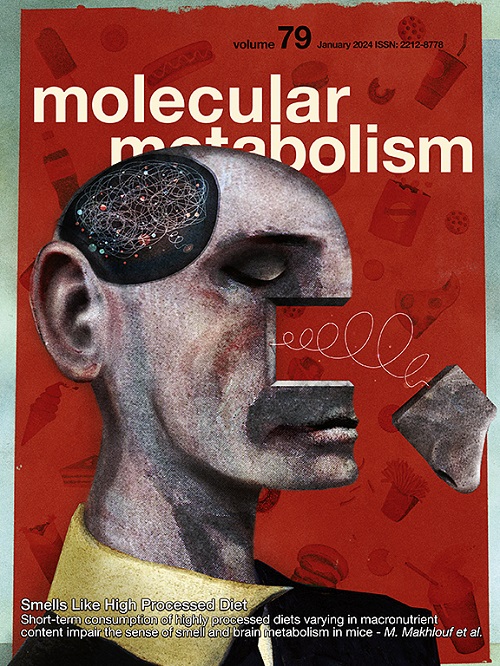HDAC5 controls a hypothalamic STAT5b-TH axis, the sympathetic activation of ATP-consuming futile cycles and adult-onset obesity in male mice
IF 7
2区 医学
Q1 ENDOCRINOLOGY & METABOLISM
引用次数: 0
Abstract
With age, metabolic perturbations accumulate to elevate our obesity burden. While age-onset obesity is mostly driven by a sedentary lifestyle and high calorie intake, genetic and epigenetic factors also play a role. Among these, members of the large histone deacetylase (HDAC) family are of particular importance as key metabolic determinants for healthy ageing, or metabolic dysfunction. Here, we aimed to interrogate the role of class 2 family member HDAC5 in controlling systemic metabolism and age-related obesity under non-obesogenic conditions. Starting at 6 months of age, we observed adult-onset obesity in chow-fed male global HDAC5-KO mice, that was accompanied by marked reductions in adrenergic-stimulated ATP-consuming futile cycles, including BAT activity and UCP1 levels, WAT-lipolysis, skeletal muscle, WAT and liver futile creatine and calcium cycles, and ultimately energy expenditure. Female mice did not differ between genotypes. The lower peripheral sympathetic nervous system (SNS) activity in mature male KO mice was linked to higher dopaminergic neuronal activity within the dorsomedial arcuate nucleus (dmARC) and elevated hypothalamic dopamine levels. Mechanistically, we reveal that hypothalamic HDAC5 acts as co-repressor of STAT5b over the control of Tyrosine hydroxylase (TH) gene transactivation, which ultimately orchestrates the activity of dmARH dopaminergic neurons and energy metabolism in male mice under non-obesogenic conditions.

HDAC5 控制着雄性小鼠的下丘脑 STAT5b-TH 轴、交感神经激活 ATP 消耗的无效循环以及成年后的肥胖症。
随着年龄的增长,新陈代谢紊乱不断累积,加重了我们的肥胖负担。虽然老年性肥胖主要是由久坐不动的生活方式和高热量摄入造成的,但遗传和表观遗传因素也在其中发挥着作用。其中,大型组蛋白去乙酰化酶(HDAC)家族成员作为健康老龄化或代谢功能障碍的关键代谢决定因素尤为重要。在此,我们旨在研究 2 类家族成员 HDAC5 在非致肥条件下控制全身代谢和年龄相关性肥胖的作用。从小鼠6个月大开始,我们观察到以饲料喂养的雄性全基因HDAC5-KO小鼠出现了成年型肥胖,与此同时,肾上腺素能刺激的ATP消耗无效循环(包括BAT活性和UCP1水平)、WAT-脂肪分解、骨骼肌、WAT和肝脏的肌酸和钙的无效循环以及最终的能量消耗都明显减少。不同基因型的雌性小鼠没有差异。成熟雄性 KO 小鼠较低的外周交感神经系统(SNS)活性与背内侧弓状核(dmARC)内较高的多巴胺能神经元活性和下丘脑多巴胺水平升高有关。从机理上讲,我们揭示了下丘脑 HDAC5 在控制酪氨酸羟化酶(TH)基因转录活化的过程中充当 STAT5b 的共抑制因子,最终在非致盲条件下协调雄性小鼠 dmARH 多巴胺能神经元的活动和能量代谢。
本文章由计算机程序翻译,如有差异,请以英文原文为准。
求助全文
约1分钟内获得全文
求助全文
来源期刊

Molecular Metabolism
ENDOCRINOLOGY & METABOLISM-
CiteScore
14.50
自引率
2.50%
发文量
219
审稿时长
43 days
期刊介绍:
Molecular Metabolism is a leading journal dedicated to sharing groundbreaking discoveries in the field of energy homeostasis and the underlying factors of metabolic disorders. These disorders include obesity, diabetes, cardiovascular disease, and cancer. Our journal focuses on publishing research driven by hypotheses and conducted to the highest standards, aiming to provide a mechanistic understanding of energy homeostasis-related behavior, physiology, and dysfunction.
We promote interdisciplinary science, covering a broad range of approaches from molecules to humans throughout the lifespan. Our goal is to contribute to transformative research in metabolism, which has the potential to revolutionize the field. By enabling progress in the prognosis, prevention, and ultimately the cure of metabolic disorders and their long-term complications, our journal seeks to better the future of health and well-being.
 求助内容:
求助内容: 应助结果提醒方式:
应助结果提醒方式:


